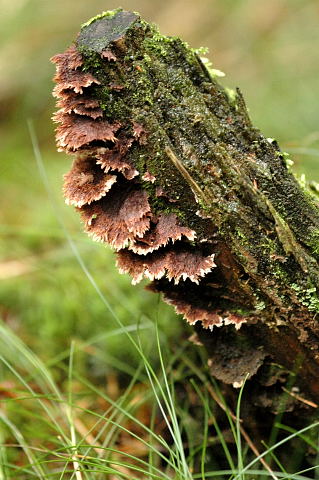
The Cantharellaceae are a family of fungi in the order Cantharellales. The family contains the chanterelles and related species, a group of fungi that superficially resemble agarics but have smooth, wrinkled, or gill-like hymenophores. Species in the family are ectomycorrhizal, forming a mutually beneficial relationship with the roots of trees and other plants. Many of the Cantharellaceae, including the chanterelle, the Pacific golden chanterelle, the horn of plenty, and the trumpet chanterelle, are not only edible, but are collected and marketed internationally on a commercial scale.

The Clavariaceae are a family of fungi in the order Agaricales. Originally the family contained most of the clavarioid fungi, but in its current sense is more restricted, albeit with a greater diversity of basidiocarp forms. Basidiocarps are variously clavarioid or agaricoid (mushroom-shaped), less commonly corticioid or hydnoid.

Omphalotus is a genus of basidiomycete mushroom, in the family Omphalotaceae, formally circumscribed by Victor Fayod in 1889. Members have the traditional cap and stem structure. They are saprobic, and fruit in clumps on the ground, adjacent to host trees. The best known and type species is the jack-o'-lantern mushroom (Omphalotus olearius). Species of Omphalotus have been mistaken for chanterelles. All Omphalotus species are presumed poisonous, causing gastrointestinal symptoms. Some Omphalotus species have bioluminescent properties.

The genus Phallus, commonly known as stinkhorns, is a group of basidiomycetes which produce a phallic, often foul-scented mushroom, from which their name is derived. The genus has a widespread distribution and, according to a 2008 estimate, contains 18 species. They belong to the family Phallaceae in the order Phallales. The best known species is the common stinkhorn.

The Physalacriaceae are a family of fungi in the order Agaricales. Species in the family have a widespread distribution, ranging from the Arctic, (Rhizomarasmius), to the tropics, e.g. Gloiocephala, and from marine sites (Mycaureola) and fresh waters (Gloiocephala) to semiarid forests (Xerula).

Boletellus obscurecoccineus, known as the rhubarb bolete, is a species of fungus in the family Boletaceae, found in Australia, New Guinea, Java, Borneo, Japan, Korea, and Taiwan. It is a distinctive and colourful bolete of the forest floor.

Hygrophoropsis is a genus of gilled fungi in the family Hygrophoropsidaceae. It was circumscribed in 1888 to contain the type species, H. aurantiaca, a widespread fungus that, based on its appearance, has been affiliated with Cantharellus, Clitocybe, and Paxillus. Modern molecular phylogenetic analysis shows that the genus belongs to the suborder Coniophorineae of the order Boletales.

Anthracophyllum is a genus of fungi in the family Omphalotaceae in the order Agaricales. The genus is widespread in tropical regions, and contains 10 species.
Epicnaphus is a genus of mushroom-forming fungi in the family Marasmiaceae. The genus, circumscribed by mycologist Rolf Singer in 1960, contains two species found in South America. Fruitbodies of Epicnaphus species are similar in appearance to those in Marasmius section Sicci, but have a smooth hymenium and broom cells of the Rotalis-type. Singer initially included only the type species, E. phalaropus, which was originally collected from fallen branches in a Bolivian rainforest. The Argentinian species E. longispora was added to the genus by Jörg Raithelhuber in 1973.
Pseudotyphula is a genus of fungus in the family Marasmiaceae. The genus is monotypic, containing the single species Pseudotyphula ochracea, found in North America. The genus was circumscribed by British mycologist E.J.H. Corner in 1953.

Datronia is a genus of poroid crust fungi in the family Polyporaceae. The genus was circumscribed by Marinus Anton Donk in 1966, with Datronia mollis as the type species. Datronia fungi cause a white rot in hardwoods. Datronia contains six species found in northern temperate areas. The most recent addition, Datronia ustulatiligna, was described in 2015 from Himachal Pradesh in India.

Thelephora is a genus of fungi in the family Thelephoraceae. The genus has a widespread distribution and contains about 50 species. Fruit bodies of species are leathery, usually brownish at maturity, and range in shape from coral-like tufts to having distinct caps. Almost all species in the genus are thought to be inedible, but Thelephora ganbajun is a gourmet fungus in Yunnan province of southwest China.
Allantula is a fungal genus in the family Pterulaceae. The genus is monotypic, containing the singles species Allantula diffusa, found in Brazil. The genus and species were described by British mycologist E.J.H. Corner in 1952.
Yunnan sudden death syndrome is a sudden unexplained death from cardiac arrest, which afflicted significant numbers of rural villagers in Yunnan province in southwest China. Cases almost always occurred during the midsummer rainy season, at an altitude of 1,800–2,400 m (5,900–7,900 ft). An estimated 400 deaths occurred over three decades.

Setulipes was a proposed genus of fungi in the family Marasmiaceae. This group of mushrooms, described by the Czech mycologist Vladimír Antonín in 1987, has a widespread distribution in north temperate areas, and would contain about 25 species.

Caripia is a fungal genus in the family Marasmiaceae. The genus is monotypic, containing the single species Caripia montagnei, commonly known as the pod parachute. It is found in tropical and subtropical regions of the Americas. Formerly classified in the Stereales, molecular analysis published in 2002 demonstrated that the fungus is a reduced form of the closely related Gymnopus.
Pterygellus is a genus of fungi in the family Cantharellaceae. It was circumscribed by the British mycologist E.J.H. Corner in 1966. According to the Dictionary of the Fungi, the genus contains five species found in tropical Asia.
Trogia venenata, also known as the little white mushroom, is a species of fungus in the family Marasmiaceae indigenous to Yunnan province, in southwest China. Consumption is deadly for both humans and mice, as the mushroom contains three toxic amino acids.












